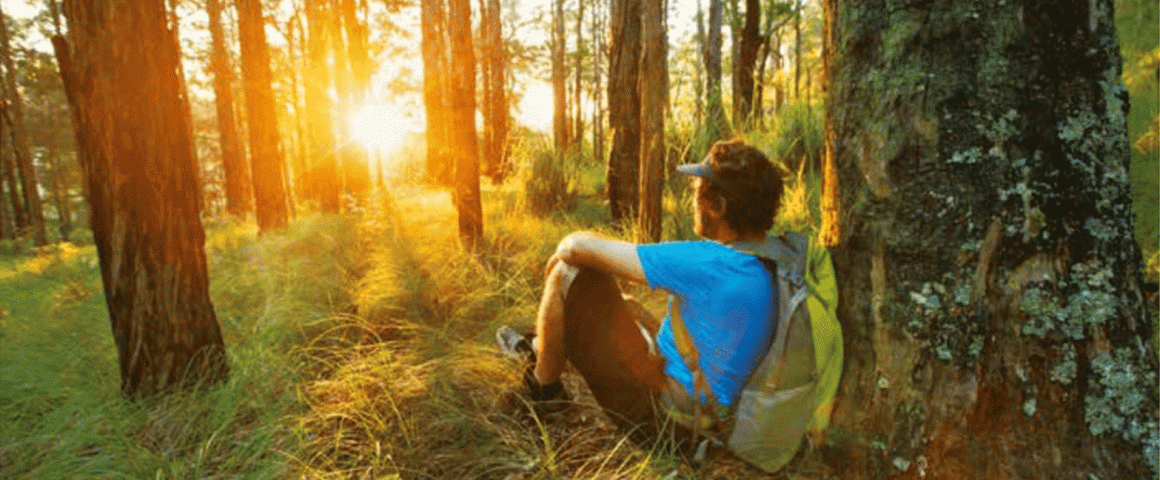The other day I was bitten by a bull ant. I was out with my son in the Royal National Park. He’s five years old now, but we were out on, for him, a longish walk—a 13km out-and-back jaunt beyond Uloola Falls. While it’s not an especially difficult outing, it’s not dead set easy either, especially if you’ve got short legs; there are ups and downs, rocks to clamber over, thigh-to-hip high steps to contend with.
It was one of those gorgeous Sydney autumn days. A flawless, hard blue sky. Warm enough that I sweated a little on the climbs. And the air was stripped of haze; when we reached the walk’s highpoint near Uloola Turrets, we could see each skyscraper in the distant CBD with perfect clarity. I can’t remember the last time I saw city air so clear.
I was wearing sandals, which I wear most days if I’m bushwalking on trails. My wife habitually complains about my filthy feet when I return home, but it seems a small price to pay for the cool-air freedom of sandals. Usually so, anyway. Not today though, because on the return leg, I noticed my foot was burning. Actually, fricking hell, it was suddenly searing. I looked down to see a great orange bull ant, an inch long, with its fangs sunk into my foot near the big toe. And it wasn’t letting go. I brushed at it, and it stayed attached. I hit it again, and it still hung on. Tenacious bugger. After repeated swat-ting it let go, but the pain was there.
Tim Macartney-Snape, as you’ll soon read in his column, suffered a similar Kenshō experience with ants, probably nearly to the day I suffered mine. Anyway, I’d forgotten how much bull ants hurt, having not being stung by one in years. This hurt. Actually, it really hurt. I mean, I’ve had worse pain—unfortunately I’ve directly experienced far too many bro-ken bones and punctured lungs (yes, the latter plural is deliberate)—but it was surprisingly sharp. I discovered later, once I got home, there’s an actual scale for the pain of bites. It’s called the Schmidt Scale. In the 1980s, an American entomologist, Justin Schmidt, devised a four-point pain scale, in which he would be the guinea pig for various insects’ bites. The bull ant rates2.5—worse than a bee sting.
When we reached Karloo Pool, a magnificent swimming hole on Kangaroo Creek, my foot was still burning, so I decided to dip it in the cooling waters for a few minutes. And then—and this is nearing the crux of this story—I convinced my son to do likewise. He resisted at first. But reluctantly he agreed, and taking off his shoes, plonked his feet into the water.
“Good, eh?” I said.
“Wow,” he replied. “That feels great.”
That night, being Sunday, I asked him what the best thing he did that week was. Although already a keen bush walker, and usually fizzing with energy, he’s in some ways already adopted the persona of a truculent teenager: If I ask what he did in school, the reply is invariably, “Nothing. “What did you learn? “Nothing.” What did you like best? “Nothing.” But to this question his answer was not playing Minecraft, or watching Andy’s Prehistoric Adventures, or eating pizza last night, it was, “Putting my feet in the water at Karloo Pool.” It was such a simple activity. Free. Accessible to anyone. And I genuinely believe he learnt more experiencing that singular joy of bracing coolness than his schoolbooks could have taught him in a week.
Similar lessons are freely available for us, too. If we take the time. And don’t limit ourselves to where we can find them. We often—and this magazine admittedly fosters this—feel that genuinely valuable outdoor experiences only happen when we engage in grand adventures. But they can also be found close to home. The Japanese have a word ”Kenshō” that essentially means through pure experience you can gain a direct understanding of reality. The problem is that in the cities and in our rushed everyday lives, distractions are far too many and far too insistent to allow such insight. But out bush, even if close to home, as long as we are willing to rid ourselves of other distractions, direct knowledge is easier to find. Megan Holbeck touches on a similar vein her column. It can be putting your hot sweaty feet in the water of a cool stream. Or sim-ply looking out to sea. Or no-mindedly listening to bird song in the bush. Staying silent, but not necessarily thinking. Let-ting nature wash over you.
James McCormack
Editor


